
A mountain chickadee will use existing cavities for a nesting area.
With nesting season upon us, it’s a good time to seek out a variety of bird nests in order to get photos of the parents bringing in food for the nestlings as well as the babies themselves.With birds everywhere, there’s bound to be some nests near where you live, whether they be cavity dwellers or nest builders.
To find birds using cavities, you can take a walk through the woods, looking for holes used in previous years.While there are only a few types of birds that actually dig out the cavities, many other types of birds will use these holes for several years after they are built.Finding a hole means there should be a bird using it this year or in another tree nearby.
If you live in an area where there are bluebird boxes, try to meet up with the person coordinating the trail to see if you can go out with them sometime to get some photos.If they do programs for people, you can offer to provide them with some photos to incorporate into their presentation.If they don’t, you can see if they’d like a photo or two for themselves as not all people who work the boxes do photography of them.A good place to find out about coordinators is either with your local Audubon Society or the Cornell Ornithological group, where coordinators from around the country provide data on their particular trail.With the advent of computers, they now are trying to get GPS locations of all the bluebird boxes in the country.
If you are able to get on with someone doing bluebird nest boxes you need to be prepared when you approach the box as the time the people want to have the box open is limited.Go to the box with several options quickly available such as heading there with both a macro lens, a zoom and some extension tubes.
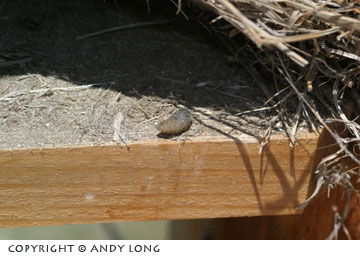
The blowfly larva is a common predator in bluebird nest boxes. They attach to the hatchlings and suck blood from them.
Having a couple of bodies ready with different combinations will make this easier. And unless you’re very steady with hand-holding your camera, a monopod comes in quite handy.A couple of the options you should try to see which works best for you include a 100mm macro lens and a zoom in the 70-200mm range with an extension tube attached that will allow you to get closer to the activity inside the box.
On a recent trip to do nesting bluebirds I realized that my 100mm macro was the lens of choice with the camera being mounted on a monopod.Depending on the light, f/stops in the range of 9.5 and 11 were used from about a foot away in order to get enough depth of field.When you’re able to get close to nests like this, this is a good place to start.Flash is another option but the appearance it gives off the inside of the box is not quite as natural.Depending on the direction the boxes face, though, you might have to use a flash in order to get enough light inside the box to photograph the babies.
Getting images of the adults coming in to feed the young creates another set of circumstances.How close you park your vehicle from the box might keep the birds from bringing in the food to feed the young.This shouldn’t take too long to figure out as you watch the behavior of the birds as they approach.With bluebird boxes, they do get used to some nearby activity as the monitors do have to approach the boxes on occasion and park nearby to observe the activity.
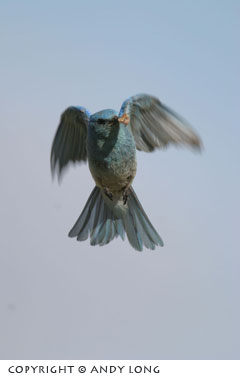
Getting in position near a nest box can provide some interesting flight shots.
If you can get close enough for your large lens, shooting from the vehicle is a perfect blind.Tele-converters and extension tubes come into play here as you want to get as large an image of the adults as possible.And with most nesting birds being pretty small, the closer proximity and greater magnification you can get the better.If you are able to get just within the focusing range of your largest lens with a converter attached, you can add an extension tube that lets you get a little closer focusing range.To do this, you should place the tele- converter on the body first followed by the extension tube and then your lens.This provides the shortest focusing range.
If working robin or other birds that build a nest in various places, you’ll need to do some more experimenting, and you’re working distance will determine what lens combinations you can try.Being prepared and having at least two set-ups handy will help, as you want to spend as little time at the nest each time you’re there.Keeping time down at the nest is critical so predators aren’t alerted to the nest by your presence.
The baby birds have enough to worry about from snakes climbing up to the nests, ants infesting the nests and blow flies laying larva in the nests that will attach themselves to the newborns and suck the blood from them. Keeping larger predators from the nest is the concern of the parents.If you notice their activity you’ll see that they take different routes to and from the nest, especially when gathering food and depositing fecal sacs. If parents drop fecal sacs in the same place every time, a predator can then wait for their next visit and then follow them back to the nest.
Predation is the main reason birds lay anywhere from four to six eggs, knowing that along the way at least one usually will not fledge.
Cavity dwellers such as woodpeckers, flickers and chickadees bring about another set of circumstances.More often than not you won’t be able to photograph the nest activity from your vehicle so you have to find a decent working range for both yourself and the birds.Going to places such as parks where there is plenty of human activity is helpful as the adults are used to people being in the area and their feeding patterns won’t likely be interrupted.As with any wildlife photography, the safety of the animals should be your first concern over getting photos for yourself.
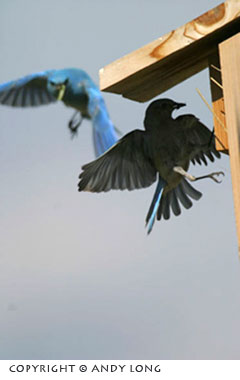
The roof overhang creates a silhouette of the one bluebird as another comes in with a meal in its mouth.
Depending on the positioning of the nest, flash might be the only option you have in order to get sufficient light on the hole.If this is so, then attaching a tele-flash onto your flash is the best option.I have seen people set up large reflectors or remote flashes near the cavity but the tele-flash proves to be just as viable an option with less work involved.
Being prepared is a key to any type of feeding activity, especially if you’re trying to capture images of the adults bringing food in for their young.At nest boxes, the adults will either land on top of the box or on a fence near the box before entering the box.This gives you time to get set up to try and get shots of them in flight before entering the box.
Other cavity dwellers usually land on tree just outside the hole before entering.In either case, they aren’t there for a long period of time so you need to be quick on the draw to get the shots that you want.Exiting the cavity is another story.Typically they will stick their head out for a quick second before flying off.Having your camera set up on a tripod with a cable release attached helps with this situation as you can be standing there and as soon as you see the head peek out you can fire away.
Wherever you live, you should be able to find some sort of nesting activity in the area.Putting up a box in your back yard with a hinged side door will allow you to have birds right at hand.Different birds require different hole sizes and a little research will let you see what size to make for the birds that nest in your area.Local Audubon groups and web searching will provide this information for you.
Let’s go shoot some birds.
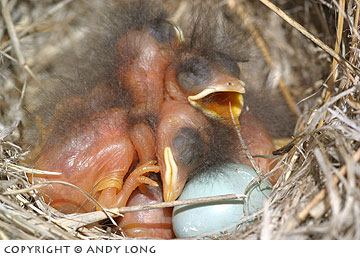
Bluebirds are naked, blind and helpless at birth as these two-day-old bluebirds are.
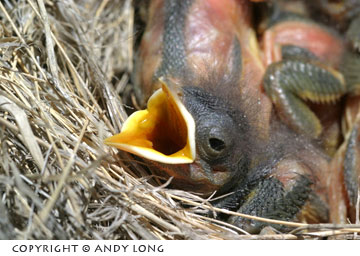
A young bluebird will instinctively open its mouth when the box is open and there is activity thinking it’s a parent with food for a meal.

A pair of larger young peer out waiting to be fed.
By Andy Long

Leave a Reply